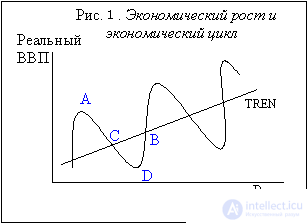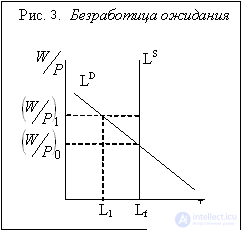Lecture
The natural rate of unemployment (u *) is the level at which full-time employment is ensured, i.e. its most effective and rational use. This means that all people who want to work find work. The natural rate of unemployment is therefore called the full-employment rate of unemployment, and the volume of output corresponding to the natural level of unemployment is called the natural output. Since full employment of the labor force means that only frictional and structural unemployment exists in the economy, the natural rate of unemployment can be calculated as the sum of the levels of frictional and structural unemployment:
u * = u fricc + u struc = (U fricc + U struc ) / L * 100%.
The current name for this indicator is the non-accelerating rate of unemployment - NAIRU (non-accelerating inflation rate of unemployment). Recall the graph of economic growth and economic cycle.

Each point of the curve depicting economic growth (Fig. 1), i.e. each point on the trend corresponds to the value of potential GDP or the state of full employment of resources (points B and C). And each point on the sinusoid representing the economic cycle corresponds to the actual GDP (points A and D).
If the actual output exceeds the potential (point A), i.e. the actual unemployment rate is below the natural level, this means that aggregate demand exceeds aggregate output. This is a situation of over-employment. When going from point B to point A, the price level rises, i.e. acceleration of inflation. Thus, when the economy is at the level of potential output (full employment), which corresponds to the natural rate of unemployment, inflation does not accelerate.
The magnitude of the natural rate of unemployment varies over time. So, in the early 60s it was 4% of the labor force, and now 6% - 7%. The reason for the increase in the natural rate of unemployment is an increase in the length of time for finding a job (that is, the length of time when people are in unemployment), which may be due to:
The first two factors provide the ability to search for a job for a longer period of time. The last two factors, meaning a change in the sex and age structure of the labor force, increase the number of people who first appeared on the labor market and looking for work (ie, an increase in the number of unemployed), increase competition in the labor market and lengthen the search for a job.
To calculate the natural level of unemployment, a dynamic model of a stable level of unemployment (the “model of labor force dynamics”) proposed by M. Friedman can be used, which was based on the fact that the main cause of unemployment is imperfect information. A part of the employed lose their job, become unemployed, and a part of the unemployed are employed and become employed. These movements (flows) are depicted in Fig. 2

Fig. 2. Model of the dynamics of labor
In steady state, the number of people who have lost their jobs and become unemployed is equal to the number of unemployed who have found work and become employed. If we designate the proportion of employed people who lost their jobs, of the total number of employed, by the letter s, and the proportion of the unemployed who found a job, of the total number of unemployed, by the letter f, then in a steady state: s * E = f * U.
Since E = L - U, then s * (LU) = f * U or s * L - s * U = f * U.
Hence f * U + s * U = s * L or U * (s + f) = s * L. Divide both sides by L, we get: U / L * (s + f) = s.
Since U / L is an indicator of unemployment, i.e. u, then from here: u = s / (s + f).
Since the premise of the model is the idea that the cause of unemployment is imperfect information, the resulting value of the unemployment rate (u) can be considered an indicator of the natural rate of unemployment (u *). So, if the average period for a person to be employed is 80 months (this means that 1/80 of the employed is losing a job every month, that is, s = 1/80), and the average period for a person to be unemployed is 5 months (therefore, monthly in the economy, 1/5 or 20% of the unemployed find work, that is, f = 0.2), then the steady level of unemployment will be u = s / (s + f) = 0.0125 / 0.2125 = 0.0588 or approximately 5.9%.
Actual unemployment may exceed its natural rate. This happens during a recession in the economy. Unemployment, caused by a recession, is cyclical unemployment. On the graph of the economic cycle (Fig. 1), this situation is represented by point D, in which actual GDP is less than potential. This means that in the economy there is under-employment of resources, i.e. actual unemployment is higher than natural. In modern conditions, the existence of cyclical unemployment is connected with the insufficiency of total expenditures in the economy reduction of aggregate demand, and c reduction of aggregate supply.
The actual unemployment rate is calculated as the percentage of the total number of unemployed to the total labor force, or as the sum of all types of unemployment (frictional, structural and cyclical):. Since the sum of the levels of frictional, structural and involuntary unemployment is equal to the natural level of unemployment, the actual unemployment rate is equal to the sum of the natural level of unemployment and the level of cyclical unemployment: u fact. = U * + u cycle.
The magnitude of the actual level of unemployment can be either greater (during a recession) or less (during a boom) than the natural rate of unemployment. Thus, during a recession, there is under-employment of resources, therefore the level of cyclical unemployment is a positive value, and during a boom, resources are over-employed, therefore the level of cyclical unemployment is negative.
Interpretation of the nature of unemployment in different macroeconomic models is different. Thus, representatives of the classical school believed that the reason for the existence of unemployment was the unwillingness (refusal) of workers to work for the wage rate offered to them. And since the workers themselves doom themselves to the unemployed state, in the classical model, unemployment is voluntary. In modern conditions, their followers - supporters of the neoclassical direction - believe that voluntary unemployment exists, and for the same reason, and include it in frictional unemployment, and therefore in a natural unemployment rate, meaning by natural unemployment rate such a level at which equilibrium in the labor market (the demand for labor is equal to the supply of labor), i.e. People who want to work for an equilibrium real wage rate, sooner or later find a job, and this is a process natural to the functioning of any economy.
However, unlike their predecessors, representatives of the neoclassical school recognize that a certain part of unemployment is of a forced nature, calling it unemployment expectations (wait unemployment). The reason for unemployment expectations is the imbalance in the labor market, associated with the establishment of a real wage rate at a level above the equilibrium market level (at which the demand for labor is equal to the supply of labor).

At the wage rate (W / P) 0 (Fig. 3), the labor market is in equilibrium at the level of full employment of the labor force (Lf). However, if the wage rate is set at (W / P) 1 , the labor supply L1 will exceed the demand for labor, and only the number of workers equal to L1 will be hired. The difference between L1 and L2 will be the expectation unemployment, which can disappear only when the wage rate is again equal to the equilibrium (W / P) 0 .
The reasons for unemployment expectations and "sticking" wage rates above the equilibrium level (wage rigidity) are:
There are 4 reasons why firms may consider it efficient to pay wages that are higher than the equilibrium.
Thus, representatives of the neoclassical direction distinguish: unemployment associated with the search for work (search unemployment), in which the labor market is in equilibrium, which is the natural rate of unemployment and which includes:
Representatives of the Keynesian trend in economic theory deny the possibility of voluntary unemployment and believe that unemployment is forced due to the insufficiency of aggregate expenses, i.e. aggregate demand, which leads to a downturn in the economy, to a recession. Thus, only cyclical unemployment is considered as a forced in the Keynesian model.
Comments
To leave a comment
Macroeconomics
Terms: Macroeconomics